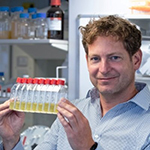Evolution, diversification and biodiversity of plants
How changes in the past inform us of the effects of environmental change in future.
By studying living and extinct species, biogeography, and the genomics underpinning different plant forms/shapes, we are revealing the evolutionary pathways that allowed plants to diversify and conquer the land.
From the remotest rainforests to windswept plains, we are shedding new light on everything from rare species to vital food crops, which make up the world’s incredible plant biodiversity.
Not only is this important for ecosystem conservation, but also for understanding past trajectories that can help predict how future environmental changes will affect plants.
Stephen Fry

Biochemistry of the plant cell wall
We are interested in the plant cell wall because it serves important biological roles — dictating the cell’s shape and size, repulsing pathogens, mopping up toxic metal ions, and gluing cells to each other within a tissue, to name but a few.
In particular, the mechanism and control of cell wall ‘loosening’ is of interest, regulating germination, growth, fruit ripening and abscission (natural detachment of parts of a plant).
Lots is still unknown about plant cell walls! Current areas of interest include:
- Enzymic mechanisms, old and new, of wall modification.
- Non-enzymic mechanisms of wall modification: role of vitamin C and hydroxyl radicals, an important chemical species.
- Evolution of primary cell wall in plants and algae.
- Cell walls as biotechnological materials.
Our preferred research strategy is to trace the ‘life histories’ of cell wall biopolymers produced in the living cell.
Justin Goodrich

Evolution of water conducting systems in plants
When land plants first evolved from aquatic algal ancestors, they had to cope with the much hotter, drier terrestrial environments. My group is interested in how land plants evolved mechanisms to limit water loss through evaporation, and to transport water from soil to their aerial photosynthetic organs. We have identified genes which help plants make a waxy, waterproof covering, termed a cuticle, on their epidermis (outermost layer).
Together, the cuticle and epidermis, provide protection against injury, infection and water-loss. In addition, we have found genes that control cell death, which is important for removing cellular contents to make the hollow pipes that transport water in plants.
We are working with a liverwort species, Marchantia polymorpha, as comparisons with flowering plants can help identify shared feature that were likely present in the earliest land plants. In addition, Marchantia polymorpha is proving a powerful tool for gene discovery, due to its relatively streamlined toolkit of developmental genes.
Our results will help shed light on how early land plants evolved and what they looked like. This may have practical applications in terms of discovering new genes involved in water acquisition and conservation.
Justin Goodrich Lab
Andrew Hudson

Plant development and evolution
I’m interested in plant development and how mutations, hybridisation (crossbreeding between genetically dissimilar parents to produce a hybrid ), and adaptation make different forms and new species.
Our research team uses mostly snapdragons (Antirrhinum species) because they are diverse in form and adapted to different extreme environments. They also hybridise with each other, making it possible to identify the genes underlying their differences using genetics and genomics methods. Genetics studies the function and composition of single genes, whereas genomics addresses all genes and their inter relationships to identify their combined influence on the organism.
We’re currently looking at two questions. The first is whether adaptations to alpine environments are passed between species by hybridisation, which may explain why alpine snapdragons have evolved quickly and more than once.
Catherine Kidner

How does plant diversity evolve?
There are around three quarters of a million species of flowering plants. Many years of work by taxonomists, professionals that sort organisms into categories, have described how species vary in how they look and behave. This can be based on (pollination strategies, flowering time, habitat requirements and other factors).
The new technologies of genome sequencing allow us to look deeper to find hidden variation between species. We compare genomes to find out how plant species differ from each other in the structure of their genomes, the types of genes they contain, and how these genes change over time. We also look for patterns in the genomes which might explain variations in speciation rates, a measure of how quickly a species gives rise to new species. Understanding how plant diversity is produced will help us to preserve it.
Richard Milne

Plant evolutionary and hybridisation
Most of my research work is collaborative with research groups in China, allowing me to dabble in a wide range of topics, with my core interests being in plant evolution, hybridisation, biogeography and invasive species.
I have an interest in natural hybrid zones, particularly those where first-generation hybrids can outcompete other hybrid types due to extreme habitat-mediated selection. I am also interested in intercontinental seed dispersal following a paper on how members of the nettle family have repeatedly crossed huge ocean barriers.
Currently I’m involved in projects looking at genetic diversity of crop species such as walnut and ramie (a type of fibre) across Asia, and the biogeography of other species in and around China. Throughout my career a lot of my research has focussed on the genus Rhododendron, characterising the invasive Rhododendron ponticum in Britain, and unravelling the complex species relationships in the genus.
A new project starting this year will be looking at the invasion of roadside habitats in Britain by salt-tolerant coastal species, asking whether such invasions have required significant evolutionary change in the species involved.
Beatriz Orosa

Understanding and improving plant immune responses to pests and diseases
My research focuses on studying the fundamental mechanisms underlying ubiquitin-mediated regulation of plant immunity, joining the two main themes of my career: plant-pathogen interactions and post-translational modifications.
The post-translational modifier ubiquitin plays vital roles in cell signalling and organismal responses to their environment. Ubiquitination is highly versatile and an indispensable component of the plant immune system with a key role in modulating the stability of immune receptors and transcriptional regulators. While plants have evolved to extensively utilise the ubiquitin machinery to support immune signalling, pathogens have evolved effector proteins to suppress the host ubiquitin pathway and are indispensable for the establishment of disease. Understanding the interplay between pathogen and host ubiquitin-mediated immunity is fundamental to the design of long-lasting resistance strategies.
My group is focused on applying innovative approaches to study the ubiquitin code that crops use to modulate the immune response. Additionally, we work to decipher how pathogens hijack the host ubiquitin pathway to promote virulence and use this knowledge to manipulate this system to promote plant resistance to pathogens. My research is opening new strategies for the development of crops with sustainable resistance against pathogens which will have a major impact on global food security.
Twitter (personal) @BeatrizOrosa Twitter (lab) @OrosaLab Linkedin
Steven Spoel

How do plants maintain health in hostile environments?
I am a Professor of Cell Signalling and Proteostasis at the University and former Head of the Institute of Molecular Plant Sciences (2018-2023). Proteostasis or protein homeostasis is the regulation of the complete set of proteins expressed by an organism, to maintain their health. My research team aims to improve plant health in an ever-changing environment. This is vital for the sustainable future of agriculture and for establishing food security for a growing global population. Our team’s current focus is to understand how dynamic changes in the epiproteome, representing the chemical modifications that control activities of cellular proteins and enzymes, enables plants to launch effective immune responses.
I am passionate about linking frontier science with industrial research and innovation. In my scientific advisory and consultancy roles, I aim to provide strategic solutions and establish inclusive environments that promote innovative thinking to tackle challenges across the plant science and Agricultural Technology sectors.
Gerben van Ooijen

How does a cell keep time?
Circadian rhythms are approximately 24-hour rhythms in the physiology or metabolism of an organism, a tissue or a cell. Circadian rhythms are a fundamental feature of the life, and misaligned circadian rhythms carry significant health consequences across life. In photosynthetic organisms, circadian defects prevent the anticipation of sunlight, which can decrease both carbon fixation and biomass production by the 'lungs of our planet' by about half.
In my lab, we use plants and algae to identify the cogs and gears of the circadian clock on cellular and molecular levels. This could lead to improvements that allow plants and algae to better fend off disease and thrive under a range of conditions - meeting the growing need for food, fuel and industrial biotechnology products.

